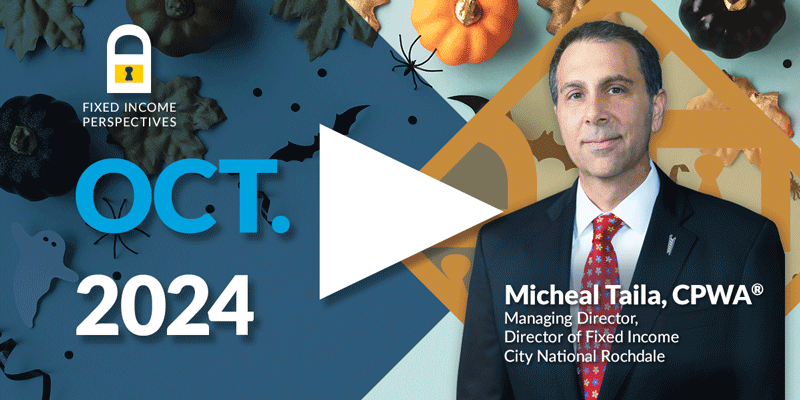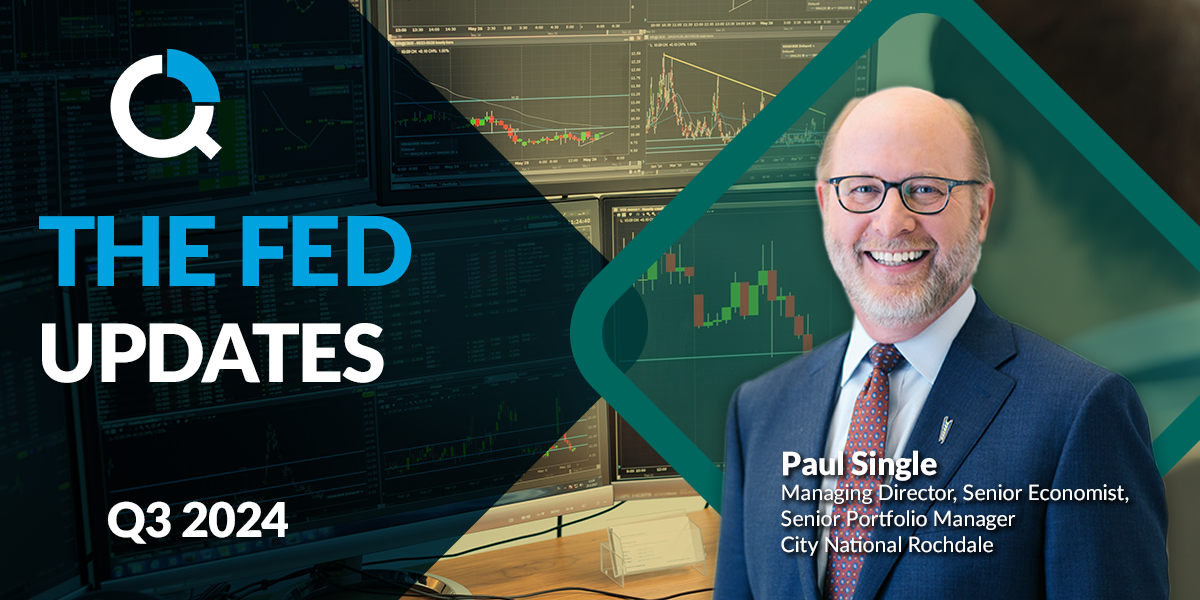

July 12, 2023
Is higher for longer still valid?
Despite the outlook for a near-term severe recession looking less likely, the market remains convinced that significant disinflation and interest rate cuts are ahead (see chart). While some decline in core personal consumption expenditures price index (PCE) inflation should be expected thanks to slowing housing inflation, broad-based disinflation is likely to remain elusive. Core PCE inflation ex-housing has averaged 4% over the past 12 months as well as YTD. Hence, housing disinflation alone, which itself is likely to be gradual, is unlikely to get core PCE inflation low enough to satisfy the Fed.
The economy remains far more resilient than the market had been expecting, inflation is likely to be stickier than expected as well, and as a result, the Fed will be biased to maintain or increase interest rates in the near term. In addition, it is unlikely to ease policy as fast as is priced in.
As such, CNR forecasts the fed funds rate to finish the year between 5%-5.25% with the 10yr Treasury yielding in the range of 4%-4.50%. The high level of yields available in investment-grade corporates, as well as U.S. Treasuries, remains very attractive.
CNR continues to have confidence in the higher for longer interest rate outlook and therefore prefers shorter maturity assets due to the material degree of yield curve inversion. Over the next several quarters and as financial conditions continue to tighten, a time will come to change course and bias allocations toward the longer end of each respective strategy with the potential to lock in higher yields and income for a longer period.
Federal Funds Rate Forecast

Source: Bloomberg as of July 7, 2023
Please note: Information is subject to change and is not a guarantee of future results.
What did the Fed decide at its recent meeting?
The Fed decided on what is known as a “hawkish pause.” It kept the federal funds rate steady at the median rate of 5.125%, but it signaled two more hikes are likely this year. The first of those hikes may come as early as the next Federal Open Markets Committee (FOMC) meeting in July.
With the Fed holding interest rates steady, it buys it time to assess the economic impact of past interest rate increases. This pause (some call it a “skip”) was not surprising. Last month Fed Chair Powell and other senior policymakers suggested there was a good chance the Fed would take a break to assess the delayed effects of past increases, which total 500 bps, and tighter credit conditions.
The impact of higher interest rates has yet to have much of an effect on the economy. It is believed to be because household wealth is high due to the low unemployment rate and strength in the household balance sheet (high level of savings, high valuation of homes and investments, and low levels of debt).
The expectation of a higher level of year-end federal funds is consistent with the Fed’s outlook for this year, which now expects stronger GDP, a lower unemployment rate, and more persistent inflation.
FOMC Projections - Federal Funds
%, mid-point

Source: Federal Reserve as of June 2023
Please note: Information is subject to change and is not a guarantee of future results.
Have U.S. equities rallied too much?
Midway through 2023, the S&P 500 is off to a very strong start for the year, with the index up 14% YTD and 21% from its October low. However, the rally has largely been driven by a handful of growth sectors and, in particular, a few mega-cap technology stocks supported by enthusiasm over developments in artificial intelligence.
By comparison, the index’s equally weighted counterpart, which assigns equal importance to each company in the index, is up a much more modest 7% (see chart). And, if we were to remove the top seven tech names entirely, the S&P 500 would be posting a 2.7% decline.
This top-heavy and narrow concentration in market gains in our minds raises concerns about the rally’s sustainability. Historically, new bull markets have seen broader participation, including from more economically sensitive value sectors.
Investors also seem to be too complacent about corporate growth prospects. Though consensus earnings estimates have come down significantly over the past several months, they have not yet discounted the risk of an economic downturn in coming quarters. In a scenario where the economy enters even a mild recession, we would expect earnings growth to contract, at least modestly.
Given this, we continue to advise caution in the near term. AI enthusiasm has raised valuations and future profit expectations, but this theme will likely take years to play out, with many eventual beneficiaries that may not yet even exist. Meanwhile, with recession risk still elevated, earnings disappointments ahead could fuel a renewed pullback in stock prices before a more durable recovery takes hold.
Equity Market Performance
As of 6/30/2023

Source: FactSet as of June 2023
The “7 Tech Titans” are Alphabet, Amazon, Apple, Meta Platforms, Microsoft, Nvidia and Tesla.
Please note: Information is subject to change and is not a guarantee of future results.
Is the manufacturing sector as dire as the ISM manufacturing index report suggests?
It probably isn’t as bad as the report indicates, but it is not a growth story. Despite being on a declining trend since 2021 (see chart) and having eight consecutive months below 50, meaning it is in a contraction phase, it is important to note that the broad view is that this sector is experiencing a slow squeeze, not a cascading downtrend.
The current downward trend is a product of the pandemic. During the lockdown, demand for many products escalated due to the need for goods to entertain the family. But since the economy reopened, consumer demand has shifted away toward services. During the early stages of the shift, manufacturers stayed busy producing products to replenish the depleted inventories. But now that stocks have been filled, the manufacturing sector has softened.
From the Fed's perspective, the economy's goods sector is better balanced than the service sector. For the goods sector, supply chain issues have improved to levels not seen since before the pandemic, helping to bring down input costs. There is also an easing of labor shortages. All of this will help keep down inflationary pressures for goods, just what the Fed wants.
ISM Manufacturing
diffusion index, seasonally adjusted

Source: Institute of Supply Management, June 2023
Please note: Information is subject to change and is not a guarantee of future results.
IMPORTANT INFORMATION
The information presented does not involve the rendering of personalized investment, financial, legal or tax advice. This presentation is not an offer to buy or sell, or a solicitation of any offer to buy or sell, any of the securities mentioned herein.
Readers are cautioned that such forward-looking statements are not a guarantee of future results and involve risks and uncertainties, and actual results may differ materially from those statements.
Certain statements contained herein may constitute projections, forecasts and other forward-looking statements, which do not reflect actual results and are based primarily upon a hypothetical set of assumptions applied to certain historical financial information. Certain information has been provided by third-party sources, and although believed to be reliable, it has not been independently verified, and its accuracy or completeness cannot be guaranteed.
Any opinions, projections, forecasts and forward-looking statements presented herein are valid as of the date of this document and are subject to change.
Investing involves risk, including the loss of principal.
This material is available to advisory and subadvised clients, as well as financial professionals working with City National Rochdale, a registered investment adviser and a wholly owned subsidiary of City National Bank. City National Bank provides investment management services through its subadvisory relationship with City National Rochdale.
Any opinions, analysis and expectations mentioned herein are as of July 12, 2023, unless otherwise noted or sourced.
©2023 City National Rochdale
INDEX DEFINITIONS
S&P 500 Index: The S&P 500 Index, or Standard & Poor’s 500 Index, is a market-capitalization-weighted index of 500 leading publicly traded companies in the U.S. It is not an exact list of the top 500 U.S. companies by market cap because there are other criteria that the index includes.
Bloomberg Barclays U.S. Corporate High Yield Bond Index measures the U.S. Dollar-denominated, high-yield, fixed-rate corporate bond market.
Moody’s Investors Service, often referred to as Moody’s, is the bond credit rating business of Moody’s Corporation, representing the company’s traditional line of business and its historical name. Moody’s Investors Service provides international financial research on bonds issued by commercial and government entities.
CPI: A consumer price index (CPI) is a price index; i.e., the price of a weighted average market basket of consumer goods and services purchased by households. Changes in measured CPI track changes in prices over time.
Stay Informed.
Get our Insights delivered straight to your inbox.
Put our insights to work for you.
If you have a client with more than $1 million in investable assets and want to find out about the benefits of our intelligently personalized portfolio management, speak with an investment consultant near you today.
If you’re a high-net-worth client who's interested in adding an experienced investment manager to your financial team, learn more about working with us here


